
Gentle Joseki, part VIII
by Pieter Mioch
An introduction to corner patterns, especially but not only
meant for kyu players.
Introduction
Hi there, it's very nice of you to keep taking the
trouble to open Gentle Joseki, thank you all. I am
getting the feeling, though, that I am starting to
repeat myself and that is not a good sign. I therefor
decided to continue for another 3 episodes (this one
included) after which I'll start something new. I'd be
thankful if you can send me some suggestions of what to
do next. Please do not forget that I am not an expert at
this game, I'm not a professional, heck I ain't even on
any dan-list anymore, sigh. Since I hate false modesty,
however, I'll do some bragging too, just to make up for
the last couple of lines. For two consecutive years my
partner and I have managed to place third in the Central
Japan amateur pair-go tournament. This in spite of the
fact that, Hiroko, who is an ex-insei too, and I never
play each other and only meet for the occasion.
Well, enough of that. And now for something different.
Probably the best known 8 dan pro from Nagoya is
Masataka Saijo Sensei. He is the one who recognized
Catalin Taranu's talent first and later became his
mentor. Long before scouting Catalin from Rumania, now
4 dan pro, Mr. Saijo was well known already thanks
to his love for the game and his active promoting go
at international events all over the world. He is a
very friendly person who loves explaining the game to
amateurs of any rank.
The first Saturday of April I was invited to come over
and help out at "Amusement Natsume". This was until
a couple of years back a real "karaoke snack" with
girls of several nationalities singing until early in
the morning and dancing on the tables. Quite a few
professionals came here to let of steam and enjoy a
glass water and whiskey. Some three years back, however,
Mr. Natsume had enough of the dancing girls and decided
to make his go-hobby his job. He always had a few go
boards stashed away under the counter but now go has
become the main thing at his place. I guess his bar
must be unique in one or more ways when realizing that
you can drink liquor, play go and sing karaoke all at
the same time. I have no idea how Mr. Natsume does it
but somehow he seems to be able to make a living like
this and his long time customers, go pro's from all
over Japan, keep coming to relax and sometimes play a
teaching game or two with well-to-do amateurs, doctors,
lawyers, you know what I'm talking about.
Since April a go club especially for foreigners has
started at Natsume's and every Saturday from two o'clock
the teaching staff, two Chinese guys graduated from the
Beijing University, a Korean girl who started out as a
hostess/waitress at Natsume but now runs her own bar,
me and a couple of middle aged Japanese ladies gather to
play with people who show up.
The first Saturday a couple of pros came to have a look
too and it goes without saying that Mr. Saijo was amongst
them. My old insei buddy Miyagawa 6 dan and Mr. Ito, 9
dan showed up escorting him. Because there was some time
to kill I showed them "Gentle Joseki". Mr. Natsume has
installed a desktop computer on his counter with a huge
monitor facing the bar chairs. "And this is my column
about joseki."
"I see you call it gentle joseki, Pieter, doesn't
that sound a little girlish?" That was Mr. Saijo whose
English is pretty good for a Japanese Go pro. "Yeah,
'guess so, but calling it "Easy Joseki" didn't sound so
good, I thought". " Oh, I see, and what do you usually
write about?" "Well, I try to keep things simple but
not boring, Saijo Sensei, last episode, for example was
about the 5-5 move. Here it is, what do you think about it?"
Well, I shouldn't have asked that question because the
three pro's kept grilling me for the next half hour
and I felt like being tortured by a three-headed 23
pro-dan monster. Although they were not at all satisfied
with my answers, they seemed to like it. After having
talked about gentle and not at all gentle joseki for
what seemed hours (to me at least) finally the first two
beginners showed up. I had prepared an easy introduction
in English about the game. Just when I was about to
start telling the two new comers the fundamentals of go,
however, Mr. Saijo tapped me on my shoulder: "You can
take over later but would you mind if I'd teach them
first?" Saijo had noticeably changed at the sight of
the two foreigners and with his glass in one hand and a
cigarette in the other he started an explanation which
was at the same time entertaining and comprehensible.
After this he didn't let go of the beginners anymore and
Ito 9 dan, Miyagawa and me sat at the counter playing a
couple of games on IGS. We used my 3d* account for this
and I tried approaching 4d* and 5d* people.
In the end Ito Sensei had to play another 3d* who
thought his opponent was just an amateur. Maybe it was
because it was Ito's first game on a computer or maybe
he had had one watery whiskey too much already because
at move 70 a group of him got killed and it seemed that
the game was over.
What happened next, however, was very impressive.
Keeping his cool and playing sharp but not unreasonable
moves Ito managed to win the game by a small margin.
Although his opponent was by no means a walkover Ito
just knew better what the biggest points were on the
board. It was rather uncanny to see something like this
to happen "live" and in front of you, white turned
around a seemingly lost game although black did not
do anything strange. Better positional judgment and a
perfect live-and-death knowledge allowing Ito to leave
his stones although the lesser player might have played
a reinforcement, these were the key to Ito's win.
Things you don't want to do
The 4-3, or "ko-moku" play is the most complicated
opening move known today. There are uncountable
variations and to master them all would take the average
person a lifetime or three. Because of this versatility
the 4-3 move is certainly worthwhile to have a closer
look at how to put it to good use. As I often do in
Gentle Joseki I'd like to approach discussing ko-moku
from the opposite direction. Since it is not humanly
possible to memorize all the patterns I'll keep it
simple and concentrate at ways of playing which are
regarded as being bad according to modern go theory. So,
memorizing these "anti-joseki" patterns will help to
stay away from bad moves and automatically make you play
the correct patterns, piece of cake.
cute move |
 |
Here it is, the 4-3 move, isn't it cute? I very much
doubt it is the best opening move possible but I doubt
it even more if anybody will come up with evidence
to the contrary in the next century. Although not as
popular as it once was, the ko-moku play is an excellent
move. It is a little low but all the same it's way more
positive compared to the 3-3 play.
|
Diagram 1 |
|
|
|
Not to discourage you but I seldom play ko-moku in
my own games. It's not that I don't like it or that
there are any hidden defects or stuff like that but
when playing ko-moku I always feel I have to play
a real "serious" game and think very hard. It goes
without saying that this is not my strong suit, I prefer
lightning games big time and the last serious games I
played were in the Insei league some 300 years ago.
(still dream about these games occasionally, they would
take the whole day and seldom finish inside 6 hours)
Well, to make good on my promise of telling you what
you shouldn't do please have a look at dia 2. Follow up
moves like the diagonal (kosumi) move and the one-space
jump (ikken-tobi) are often worth considering in case of
having played at 4-4 (hoshi) but not with the ko-moku opening.
Never mind anybody's advice |
 |
You won't hear me say, though, that you -never- should
play at either A or B as a follow up move to the 4-3
play. It is safe to say, however, that A and B are
regarded as bad moves. "How bad?" you ask? Humpf, as all
good questions, that is not easy to answer. If the best
move would be worth ten points than I guess that A and
B are roughly the same value of between 8-9 points. In
other words, as a novice to this game I don't think that
there is anything wrong with freely playing them in your
own games, never mind what anybody is telling you about
books this and books that.
|
Diagram 1 |
|
|
|
So, what -are- the ten pointers? Which moves are given
as the best continuation after having played at the 4-3 point?
Once Again, a Shimari |
 |
There is no move which can hold a candle to black one in
dia 3. Likewise, there is no formation as omnipotent as
this small-knight's enclosure (shimari). If in an even
game black can make two shimaries with his first four
moves he can never have a bad game.
|
Diagram 3 |
|
|
|
Unbeatable? |
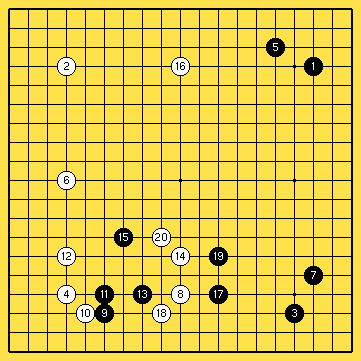 |
15th Meijin league, January 1991
black: Cho Chikun
white: Rin Kaiho (+resign)
Now I thought that what I just said about black never
having a bad game when making two shimaries was rather
an understatement.
I just finished searching for a good game example where
black gets an easy win because of his shimaries. Till
my surprise, however, *all* the five games I managed
to find were won by white! It seems the vitality of
the center oriented way of playing helps to reinforce
one's confidence or something, that is to say, I have
no clue as to why white wins all the games, probably coincidence.
|
Diagram 3a |
|
|
|
Like I said before, however, the ko-moku opening is a
kind of "serious" instead of the ol' rough'n tumble
style street fighting it shows an attitude which some
regard as more mature but others just think is boring
(who said that?). When playing with a shimari it shows
that you prefer to build solid, strong positions from
where you will develop steadily while making territory.
Opposite to this way of playing would be moyo making
and preferring making influence instead of points. Both
ways of placing your stones on the board are, of course,
perfectly common. Even if you feel that one of them
doesn't suit your temperament or character I still think
it would be a very good idea to try both, playing solid
and making territory versus playing light and building moyos.
Orthodox moves |
 |
In dia 4 A-E show the moves which are regarded as
orthodox, i.e. these are the plays black should be
playing according to the book. The moves C, D and
especially E are not very tight, however, and do not
help black ensuring territory yet. Properly speaking,
move E is not a follow up but a whole-board kind of
play, not necessarily regarding the corner as being important.
|
Diagram 4 |
|
|
|
Let me repeat what I told you earlier about moves you
shouldn't play. In dias 5-5c you can see moves which
are regarded as being bad. None of those, however, will
cost you the game. This even goes for pro's although it
will be next to impossible to find a game record of a
pro actually using one of these moves in the opening.
To be sure, they are slack and have other shortcomings
but I wouldn't worry about it too much if I were you.
Try them, memorize them and when you feel you got an
idea why they're not too sharp keep them for special
occasions (explaining the game to your mother in law or
something like that).
Non- Standard Moves |
 |
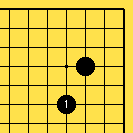 |
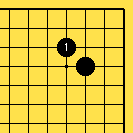 |
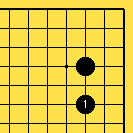 |
|
I like the moves in dia 5-5c, though, just copying pro
moves is good too, of course, but I honestly think that
the road to fast improvement is playing lesser moves
and come to understand why they're not so hot. You can
be sure, however, that after the game, no matter what
the result might be your opponent will keep telling you
these moves cannot be good and you shouldn't be playing
them and tons more of talk you sometimes have to put up
with after the game which does not contribute to the
game very much, although it can be great fun at times.
|
Diagram 5, 5a, 5b & 5c |
|
|
|
Up to here I briefly described what to do with your
ko-moku stone if you have the chance of playing a second
move. It is, however, likely that you often do not have
the chance of doing so and your opponent will play an
approach move first.
Dealing With An Approach Move |
 |
This is the typical way of thwarting black's shimari
plans, the white "keima-kakari" or small knight approach
move. Let's have a look at what you shouldn't be doing
after this when playing black.
|
Diagram 6 |
|
|
|
Not Good Enough |
 |
Black one in dia 7 is too small. The corner territory
is only worth about six points, this does not justify
the two black moves here. As I often said in previous
episodes, one (opening) move should be worth about 5 points.
|
Diagram 7 |
|
|
|
Too Tight |
 |
Dia 7a shows a likely continuation. The moves look
normal but the result is so so, not really bad for black
but a little slack . Not game-losing but a bit too
tight, have a look at a better shape for black in dia 7b.
|
Diagram 7a |
|
|
|
Superior Shape |
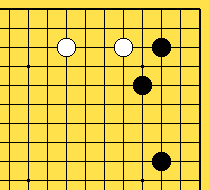 |
Undoubtedly the result in dia 7a is more solid for black
compared to this diagram, dia 7b. All the same, the
result in dia 7b is a joseki while dia 7a is not because
black is over concentrated, spending too many moves in a
cramped place, 'kind of how you feel after a huge dinner
and the cake and coffee arrives just a little too early.
|
Diagram 7b |
|
|
|
Too Solid |
 |
In dia 8 you can see yet another move, black one, which
is not standard and thought of as too solid, over
protective if you want. Instead of black one a move at
either A or B would be better.
|
Diagram 8 |
|
|
|
Shusaku's Kosumi |
 |
This diagonal move is a border case. It is the famous
"Shusaku kosumi" named after the 19th century Go-Master
who virtually won all his games on black by playing it.
Strange when you think about it, you can invent and play
an excellent new move but as long as you're not going to
win any games with it people will think it's worthless.
|
Diagram 9 |
|
|
|
According to modern go theory this move is not good
enough if black has to give komi to white to make up
for the advantage of having the first move. It's a very
solid move, however, and I'm fond of it and often use
it, when I play ko-moku, almost never, that is.
It's also still being used in pro games which might help
you a bit more to convince you it's playable.
One more word about the Shusaku kosumi, it is especially
nice and easy to use when realizing that you have four
next possible moves (compare this to the usual amount,
which is about two or three).
A Shuei Game |
 |
1875-08-22
black: Shuei
white: Nakagawa (+2pt)
The reason I selected the game of the 19th century shown
in dia 10 is because when looking at it even a person
who never played a game in his life can get an idea
of what you can use a stone at the 4-3 point for. We
have a shimari (upper right white formation) a hasami
(pincer) at the left, the famous Shusaku kosumi in the
lower right and an alternative way of approaching the
opponent's 5-3 stone (lower left) with another move than
at 4-3.
|
Diagram 10 |
|
|
|
I love the old master's games and I know that if you can
bring yourself to replay say 3 of such games twice per
day and manage to keep it up for a month your go skill
will dramatically improve. Not that there's anything
wrong with modern games but the fighting of today is of
such ferocity and is so complicated that it is very hard
for players other than top amateurs level players or up
to learn something from them without any explanation.
Older masters can play fierce too, of course, but old
games were played with virtually no time limit so that
top pros of these days had a very different mentality
than their modern counter parts. They took their time
and thought twice before embarking on a rash sequence of
moves, the outcome of which is often far from clear.
In the last centuries time allowances have become
shorter and shorter. In Korea 3 hours per person is
common and it can be expected that the 5-hour allowance
used in Japan will get shortened too. (this is already
happening, not in all games, though) This is a very good
tendency for amateurs who love to see pro games getting
bloodier and bloodier, the less time pros have the
higher the possibility is that the go board will turn in
a raging full-scale battlefield right from move one.
Well, back to business, the ko-moku move. The most
common approach move is the knight's move or keima
kakari. Now black has three choices:
- solidify the 4-3 point by playing an extension
- playing a pincer and see what white wants
- ignore white altogether and play somewhere else
About Six Possibilities |
 |
In dia 11 you can see the defensive oriented moves which
black can play if he doesn't want to play a pincer. Move
F is special and usually not played but certainly not
unplayable.
If black would answer at E the situation reverts to a
5-5 joseki (dia 23 in GJ-VII) were black's first move in
the corner was at E, white plays 1 and black answers at
ko-moku.
|
Diagram 11 |
|
|
|
You guessed already that my recommendation here is the
play at A, it is solid and easy to understand, there is
not much mischief your opponent can try to cook up. I'll
show you an "and everybody lived happily ever after"
joseki to give you an idea you can work with.
All Peace and Quiet? |
 |
Dia 12 shows a sequence of both players can be happy with, however..
|
Diagram 12 |
|
|
|
Beyond Joseki |
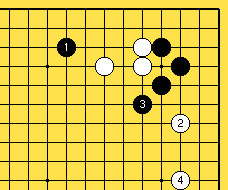 |
Things can get hairy easily as you can see in dia 12a.
Once black start throwing his weight around and plays
aggressively at 1 white will immediately make clear
he is not in the least impressed and start a counter
offensive at 2. After white 4 you are in no-man's-land
and you'll have to figure out what to do next by looking
at the whole board and not overestimating your own
fighting skill.
|
Diagram 12a |
|
|
|
Pincers |
 |
In dia 13 I've tried to rank the possible pincers A-G
in order of commonness. The play at G is not often seen
(but possible) and A is gold record all-time favorite.
Its main feature is that the situation does not settle
easy and that there are numerous variations the results
of which are not at all similar.
|
Diagram 13 |
|
|
|
When starting on Gentle Joseki 8, a month ago, I started
to use the 4-3 move in my own games and it seemed to
work contagious because many of my opponents started
playing at 4-3 too. About 90% of my opponents played the
A pincer in no time and I decided to play black 2 in dia
14 a couple of times.
In Love, Again |
 |
I've been in love with this move ever since I saw it for
the first time, some 14 years ago. It's perfect to catch
your opponent off-guard with and it works very well with
a black stone in the upper left corner to back it up.
|
Diagram 14 |
|
|
|
Looks Vital, But ... |
 |
White 1 in dia 15 may seem as a logical move (ergo, it
is logical, moving between two enemy stones in a way
they cannot expect to link up, ever) but it is a miss
fire. Black quietly plays the forcing moves of 2 and 4
and next comes back at 6 or A. White has no continuation
which will make white 1 coming out good. White one only
helped black strengthen himself and white only got a
few points in the right corner back as compensation. The
corner, by the way, which was his to start with.
|
Diagram 15 |
|
|
|
There are plenty of nice cozy joseki I could show you
but since we're at the end of this episode I'll show you
a long and difficult one.
Sacrifice |
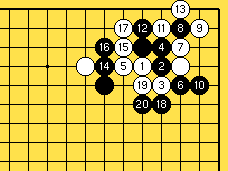 |
Black 2 is natural, white 5 is trying to link
his own stones together while at the same time keeping
black separated. Black 10 is an unexpected move but once
you get to think about it the only way of saving the
situation is by making a sacrifice. Up to 20 black more
or less has sealed white off, the result is about equal.
|
Diagram 16 |
|
|
|
Some defects Left But Equal Result |
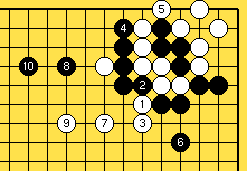 |
Black's formation, however, is by no means
without its defects. White may very well continue with
a play at one and starting a large-scale fight. Black's
groups are not weak, however, and he should be able to
handle the situation.
|
Diagram 16a |
|
|
|
This is all for this time, I will continue with the 4-3
point and its variations in the next episode of Gentle
Joseki, that will be episode 9. I still have to think up
something "tying everything together and make it look
good conclusion" for episode 10.
Be sure to come back next month for the next episode of "Gentle Joseki"
Appendix 01
Index of joseki's mentioned in this episode:
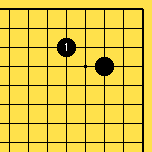
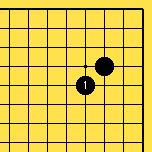
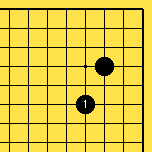

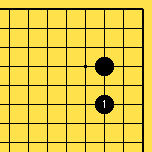

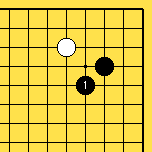
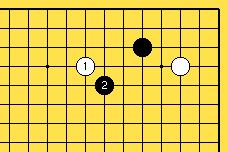
Appendix 02
Some Japanese words and their English equivalents:
| TERMS |
|---|
| aji |
taste; remaining possibilities, however distant they may be |
| atari |
"check" on at least 1 stone |
| dan |
ranking system for stronger players |
| fuseki |
opening |
| gote |
not being able to leave the current situation first,
allowing your opponent to be able the play elsewhere first |
| hoshi |
star; any of the 9 dots one the go board,
the middle one is called "Tengen" (=center/origin of heaven).
Hoshi is often used when talking about an opening move
on the 4-4 point. |
| joseki |
a sequence of moves (in the corner) giving both players
a locally equal results |
| kakari |
approach move to the corner |
| kikashi |
a move which is almost impossible to ignore,
also "forcing move" |
| ko |
situation which occurs when it is possible to immediately re-capture
the stone your opponent played in the previous move to
capture 1 of your stones.
Since there is no end to this there is the ko-rule,
which prohibits a player to exactly recreate a previous
board position. |
| komi |
compensation for white (usually 5-7 points) since black
gets to play the first move. (often there is a half point komi,
as in 5.5 stones komi, to prevent a game from ending
in a draw) |
| komoku |
the 4-3 point |
| kori-gatachi |
inefficient shape, uneconomical, using to many stones
to make only few points (hollow wall) |
| kyu |
rating system used for intermediate players |
| miai |
of equal value |
| moyo |
large framework often forcing the opponent to (try to)
reduce it drastically in order to stay in the game |
| ni-ren-sei |
two 4-4 moves one the same side of the board |
| ponnuki |
the name of the shape when 4 stones capture one enemy stone |
| san-ren-sei |
3 hoshi of the same color at the same side of the board |
| sente |
having the opportunity to play elsewhere first
leaving the current situation.
(example: He had sente so he decided to play tenuki) |
| shimari |
"closing" (the corner) formation, any 2 moves which effectively
seal the corner, also "enclosure". |
| shin-fuseki |
"New Opening" a way of playing starting in the 1930's which
does not accept the go-theory of the 19 century as being
without its weak points. |
| tatami |
thick mats of woven rush stuffed with straw,
traditional flooring |
| tenuki |
playing else first when judging the current situation
does not require an immediate follow up |
| warui |
bad |
Copyright by
Pieter Mioch, May 2001
